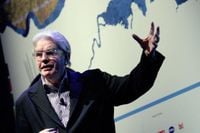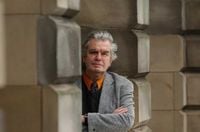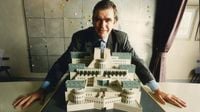Sir Terry Farrell, the celebrated British architect renowned for his exuberant postmodern style and iconic landmarks such as London’s MI6 headquarters and the TV-am studios, has died at the age of 87. Farrell’s passing, announced by his architecture practice Farrells on September 29, 2025, marks the end of a transformative era in British and international architecture. His influence, spanning more than half a century, is woven into the fabric of city skylines from London to Hong Kong and Shenzhen.
Born in Cheshire in 1938, Farrell’s early fascination with architecture was shaped by the modernist movement. After graduating from Newcastle University School in 1961, he pursued a master’s degree in Urban Planning at the University of Pennsylvania, where American modernism left a lasting impression on his evolving design sensibility. But even as he admired the sleek lines and functional forms of mid-century America, Farrell would soon chart his own, more playful course.
In 1965, Farrell teamed up with Nicholas Grimshaw, another future giant of British architecture, to form the Farrell/Grimshaw Partnership. Together, they embraced the stripped-down, hi-tech ethos of the era, delivering projects such as the aluminium-clad 125 Park Road residential block in London and the innovative Herman Miller Factory in Bath. These early works were characterized by their minimalist aesthetic, echoing the prevailing architectural orthodoxy that form should follow function.
Yet, as Farrell himself would later recount, he found the minimalist creed increasingly restrictive. "The modernism that was around before the 1980s was very grey, restrictive, utilitarian and quite doctrinaire really," he reflected, as reported by BBC News. This sense of constraint led to the amicable split with Grimshaw in 1980, after which Farrell established his own practice—Terry Farrell & Partners, now known simply as Farrells.
Farrell’s breakthrough as a solo practitioner came in 1982 with the TV-am headquarters in Camden, North London. The building, a riot of color and wit, featured a pastiche of historical styles and, most memorably, a row of giant breakfast eggcups perched on its roof. The Royal Academy dubbed it a "pop building, through its sheer abundance of metaphor." Farrell himself described the project as a "tremendous release," a chance to embrace exuberance and humor in architecture.
But it was the MI6 headquarters, completed in 1994 on the banks of the Thames at Vauxhall Bridge, that cemented Farrell’s reputation in the public imagination. The fortress-like edifice, clad in mirrored green glass and Italian marble, blended Art Deco, Aztec, and even whimsical elements—conical fir trees jutting from the façade. The building not only became a London landmark but also achieved global fame as the cinematic home of James Bond’s secret service. According to BBC News, Farrell was initially told only that the building was for a government client, and he guessed (incorrectly) that it might be for the Department of the Environment.
Farrell’s portfolio extended far beyond these headline projects. His work on the Charing Cross Station redesign and the regeneration of the Comyn Ching Triangle in Covent Garden showcased his commitment to revitalizing urban spaces through adaptation and conversion, rather than demolition. As his firm noted in a statement, "Terry constantly argued for a more responsive, responsible approach to large-scale projects with adaption and conversion as a creative and viable option to wholesale demolition and rebuild."
His influence was not limited to the UK. In the late 1990s, Farrell’s practice expanded into Asia, where he designed some of the world’s largest and most distinctive buildings. The Peak Tower in Hong Kong, completed in 1997, is a striking upturned crescent that seems to balance atop four concrete legs—an homage to both Chinese architectural traditions and the city’s modern dynamism. In China, his Beijing South and Guangzhou South railway stations set new standards for scale and spectacle, while the 441-metre-tall KK100 skyscraper in Shenzhen became the tallest building designed by a British architect.
Environmental innovation and urbanism were central themes throughout Farrell’s career. In 2023, he helped launch the £4.6 million Farrell Centre in Newcastle, a gallery and community space dedicated to architectural discourse and sustainable design. The centre, partly funded by Farrell and housing his donated archive, opened with an exhibition imagining buildings grown from fungus and other ecological materials—a testament to his forward-thinking approach. As Dezeen reported, the centre aims to "encourage discourse on architecture and planning, both in the city and at a global scale."
Farrell’s commitment to urbanism extended into the realm of policy. His enduring advocacy for a holistic, people-centered approach to city planning helped shape UK government policy on the built environment. The firm’s statement emphasized that Farrell "will be remembered as the UK’s leading architect planner whose enduring commitment to urbanism has helped shape government policy on key built environment issues."
Recognition of Farrell’s contributions came in many forms. He was appointed Officer of the Order of the British Empire (OBE) in 1978, promoted to Commander (CBE) in 1996, and knighted for services to architecture and urban design in 2001. In 2017, he received the Royal Town Planning Institute’s Gold Medal, joining a select group of architects honored for their impact on urban planning.
Farrell’s approach was shaped by a belief in social mobility and a distaste for the British class system, which he saw as a barrier to opportunity. As his firm’s statement noted, "He believed the class system to be a huge force in British society, which limited opportunities for the ‘many,’ resulting in a democratic impoverishment in our society." He was also a dedicated educator, teaching at institutions including the University of Pennsylvania, Cambridge University, and the University of London.
Not all of Farrell’s work was flamboyant. He demonstrated restraint in projects like the Home Office building in London and showed sensitivity in blending modern elements with historic structures at the Royal Institution and Newcastle’s Great North Museum. His versatility and willingness to reference architectural history set him apart from the doctrinaire modernists of his youth.
Farrell’s personal life was as rich as his professional legacy. He lived with his wife of 18 years, Mei Xin, and was a father, grandfather, and great-grandfather. His family, along with colleagues and admirers around the world, mourns the passing of a true maverick and non-conformist—a man who, as his firm put it, "was never quite part of the ‘architecture club’, often going against the architectural establishment."
With his passing, the world has lost an architect whose buildings continue to surprise, delight, and provoke conversation. The skylines he helped shape, and the ideas he championed, will endure long after the news of his death fades from the headlines.






